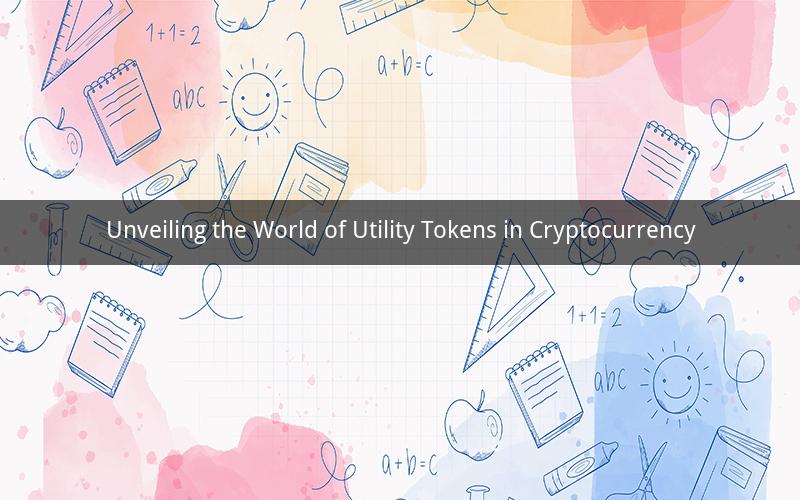
Introduction:
In the rapidly evolving world of cryptocurrencies, the term "utility token" has gained significant attention. But what exactly is a utility token? How does it differ from other types of tokens? This article delves into the concept of utility tokens, exploring their features, benefits, and the impact they have on the crypto ecosystem.
What is a Utility Token?
A utility token is a type of digital asset that is designed to provide access to a specific service or product within a blockchain-based ecosystem. Unlike security tokens, which are issued as investment contracts, utility tokens are primarily used for the functionality of a platform or application. They offer real-world utility and are often referred to as "functional tokens."
How Utility Tokens Work
Utility tokens are typically integrated into a blockchain platform or application, allowing users to access certain features or services. These tokens serve as a medium of exchange, providing value and incentivizing participation within the ecosystem. Here's how utility tokens work:
1. Issuance: A utility token is created by a project or organization through a token sale or ICO (Initial Coin Offering). The project outlines the purpose and functionality of the token in its whitepaper.
2. Distribution: Utility tokens are distributed to investors, early adopters, and participants who contribute to the project's development. This distribution ensures widespread adoption and utilization of the token.
3. Functionality: Utility tokens are used to access specific services or products within the ecosystem. For example, a utility token might be used to purchase goods or services on a decentralized marketplace or to participate in a decentralized application (DApp).
4. Incentivization: Utility tokens can incentivize users to engage with the platform or application. By rewarding users with tokens, the project encourages active participation and fosters a vibrant community.
Benefits of Utility Tokens
Utility tokens offer several benefits, making them an attractive option for both businesses and users within the crypto ecosystem:
1. Accessibility: Utility tokens provide a decentralized and accessible means of accessing services or products, removing the need for traditional intermediaries.
2. Cost-Effective: By using utility tokens, users can save on transaction fees and other costs associated with traditional payment methods.
3. Incentivization: Utility tokens incentivize users to engage with the platform or application, driving adoption and fostering a vibrant community.
4. Scalability: Utility tokens can be easily integrated into various platforms and applications, making them a versatile solution for businesses.
5. Transparency: The blockchain technology underlying utility tokens ensures transparency and immutability, providing users with a secure and trustworthy environment.
Examples of Utility Tokens
Several well-known projects have implemented utility tokens to enhance their platforms and applications. Here are a few examples:
1. Ethereum (ETH): Ethereum is a blockchain platform that enables the creation of decentralized applications (DApps). Its native token, Ether (ETH), is a utility token used to pay for transaction fees and operate the network.
2. Binance Coin (BNB): Binance Coin is the native token of the Binance exchange. It can be used to pay for transaction fees, participate in governance, and access exclusive services within the Binance ecosystem.
3. Chainlink (LINK): Chainlink is a decentralized oracle network that connects smart contracts with real-world data. Its native token, LINK, is used to pay for data feeds and services within the Chainlink network.
4. Uniswap (UNI): Uniswap is a decentralized exchange that facilitates the trading of various cryptocurrencies. Its native token, UNI, is used for governance, liquidity incentives, and discounts on fees.
5. Decentraland (MANA): Decentraland is a virtual reality platform that allows users to create, experience, and monetize content and applications. Its native token, MANA, is used to purchase land, create experiences, and participate in the platform's governance.
Frequently Asked Questions (FAQs)
1. What is the difference between a utility token and a security token?
A utility token is used for accessing services or products within a specific ecosystem, while a security token is an investment contract offering ownership or a share in the underlying company.
2. Can utility tokens be used as a medium of exchange?
Yes, utility tokens can be used as a medium of exchange within the ecosystem they are designed for, allowing users to purchase goods or services.
3. Are utility tokens subject to regulatory oversight?
The regulatory status of utility tokens varies by jurisdiction. While some countries have implemented regulations for utility tokens, others have yet to establish clear guidelines.
4. Can utility tokens appreciate in value like cryptocurrencies?
While utility tokens can increase in value, their primary purpose is to provide access to services or products within a specific ecosystem, not to be a speculative investment.
5. How can I determine the value of a utility token?
The value of a utility token is influenced by factors such as its demand, the utility it provides, and the overall success of the ecosystem it belongs to. Conducting thorough research and analysis can help determine the value of a utility token.
Conclusion:
Utility tokens have become an integral part of the crypto ecosystem, offering real-world utility and driving adoption of blockchain-based platforms and applications. Understanding the concept of utility tokens and their benefits can help individuals and businesses navigate the world of cryptocurrencies more effectively. As the crypto industry continues to evolve, utility tokens will undoubtedly play a crucial role in shaping its future.